Abstract
The electrochemical reduction of CO2 (CO2RR) to valuable chemicals and fuels is a promising strategy for addressing environmental challenges. Graphitic carbon nitride (g-C3N4) is a promising electrocatalyst for CO2 reduction. However, poor electron transfer and low CO2 affinity often limit its catalytic performance. In this study, we employ density functional theory (DFT) calculations to systematically investigate the effect of various non-metal dopants (B, P, O, and S) on the electronic structure and CO2 adsorption properties of g-C3N4. Our results demonstrated that O-C3N4 preferentially catalyzes the formation of HCOOH with a low limiting potential of −0.12 V. Meanwhile, S-C3N4 efficiently promotes the generation of CH2O, CH3OH, and CH4 at a limiting potential of −0.58 V, as well as CO at −0.77 V. These findings provide valuable insights toward the rational design of effective non-metal-doped g-C3N4 catalysts for efficient CO2 conversion.
1. Introduction
Carbon dioxide (CO2) is vital for life on Earth due to its role in the carbon cycle, but excessive levels can harm the environment and human health. The persistent concern over CO2 emissions has led to intense research into carbon capture and utilization technologies, making it a critical focus area. Among these, carbon dioxide reduction (CO2RR) is one of the crucial processes for achieving carbon recycling and mitigating environmental issues stemming from excessive CO2 emissions [1], and it has garnered widespread attention [2,3]. Electrochemical CO2 reduction involves multiple transfer processes, including multi-electron and multi-proton pathways, that lead to the formation of various products. The products of CO2RR are formed through multiple reaction pathways, including carbon monoxide (CO) and formic acid (HCOOH), formed via two-electron pathways; formaldehyde (HCHO), formed via four-electron pathways; methanol (CH3OH), formed via six-electron pathways; methane (CH4), formed via eight-electron pathways; and ethylene (C2H4), formed via twelve-electron pathways, as well as some other products [4]. These products are especially significant due to their industrial relevance and their potential to mitigate CO2 emissions. However, the performance of CO2RR is limited by several factors, including its poor product selectivity and high overpotential. Thus, searching for CO2RR electrocatalysts with high selectivity and activity is significant.
In the past few decades, continuous efforts have been devoted to improving the performance of CO2RR. Metal-free materials are becoming highly promising alternatives for various electrochemical reactions due to their excellent activity, high-temperature stability, and low cost [5,6,7,8,9,10]. As an eco-friendly and sustainable semiconductor material, graphitic carbon nitride (g-C3N4) possesses excellent electronic characteristics, favorable chemical durability, and a low production cost, factors which are attracting increasing attention [11,12,13,14]. It is considered an organic semiconductor, mainly composed of carbon and nitrogen, which are among the most abundant elements on Earth [15]. g-C3N4-based materials have proven to be excellent candidates for various applications, including photocatalysis, electrocatalysis, energy conversion, and environmental remediation [16,17,18,19,20,21,22]. Previous studies have demonstrated that incorporating transition metals (TMs) could significantly enhance the catalytic activity of g-C3N4 in CO2 reduction [23,24,25,26]. However, TM-embedded g-C3N4 is generally toxic and expensive, considerably limiting its large-scale application. Therefore, it remains a question of interest whether non-metal-doped g-C3N4 is an efficient electrocatalyst for CO2RR.
Recently, numerous experimental [27,28,29,30,31,32,33,34,35,36] and theoretical [27,31,36,37,38,39,40,41,42] studies have been conducted on the structure and electronic properties of pristine g-C3N4 and non-metal-doped g-C3N4. In 2017, Fu et al. [43] reported on the efficiency of photocatalytic CO2 reduction using hierarchical porous O-doped g-C3N4 nanotubes (OCN-Tubes). The hierarchical OCN-Tubes showed excellent photocatalytic CO2 reduction performance, with a methanol evolution rate of 0.88 µmol g−1 h−1, which was five times higher than bulk g-C3N4 (0.17 µmol g−1 h−1). In 2020, Wei et al. [40] studied the electronic characteristics of pristine and boron-doped monolayer g-C3N4. They found that the energy band gap was reduced from 3.06 eV to 1.33–1.80 eV because of the introduction of boron impurities at three sites (N2, C1, interstitial). Furthermore, the interstitial doping of B atoms significantly promotes the adsorption of pollutants by g-C3N4. Ranjbakhsh et al. [27] synthesized and investigated the mechanisms of CO2 conversion into value-added products using P-doped g-C3N4 (PCN). They found that methane could be easily desorbed from the PCN surface. The conversion of CO2 to CH4 on the P-doped g-C3N4 had a Gibbs activation energy of 3.26 eV. In addition, Wang et al. [44] reported that photoactivity could be improved by S doping to produce CH3OH. Moreover, Arumugam et al. [45] reported that CH4 was the main product of CO2 reduction by B-, P-, O-, and S-doped g-C3N4 catalysts, with CH4 yields of 28.50, 31.80, 38.00, and 55.10 nmol/(mLH2O·gcat) for B-, P-, O-, and S-doped g-C3N4, respectively, and 22.10 nmol/(mLH2O·gcat) for pristine g-C3N4.
Inspired by previous studies, we systematically investigated the mechanisms of CO2RR using non-metal (B, P, O, and S)-doped g-C3N4 (NM-C3N4) using density functional theory (DFT).
We analyzed structural stability, electronic properties, and reaction pathways, focusing on key the intermediates of carboxylate (COOH) and formate (OCHO), leading to C1 products (CO, HCOOH, HCHO, CH3OH, and CH4). Limiting potential calculations determined the most favorable pathways and product selectivity. Our findings offer fundamental insights into designing efficient and sustainable non-metal-based electrocatalysts for CO2 reduction.
2. Results and Discussion
2.1. Geometric Structures of Pristine g-C3N4 and NM-C3N4
According to the symmetry of the tri-s-triazine structure of pristine g-C3N4, we investigated various possible doping sites for NM-C3N4. Non-metal dopants, including B, P, O, and S, can occupy one of five substitutional positions (C1, C2, N1, N2, and N3) or interstitial positions, as depicted in Figure S1. To evaluate the stability of the NM-C3N4 structures, their formation energies were calculated and are summarized in Table S1. The optimized structures of each doping configuration are presented in Figure 1. Figure 1a,b illustrate the most stable structures for B-3N4 and P-C3N4, both featuring dopants located at the C1 site. In contrast, the optimal doping sites for O-C3N4 and S-C3N4 are the N2 site (see Figure 1c,d). The primary factors allowing B and P to occupy the C1 position are their capacities to coordinate effectively with the three neighboring N atoms in the pristine g-C3N4 lattice. In contrast, O and S atoms prefer the N2 site due to their placement within the same chemical group and their efficient coordination with two adjacent carbon atoms, yielding greater stability compared to alternative doping sites. Additionally, the calculated formation energies for, B-C3N4, P-C3N4, O-C3N4, and S-C3N4 are −1.23, 0.33, −0.49, and 0.29 eV, respectively.
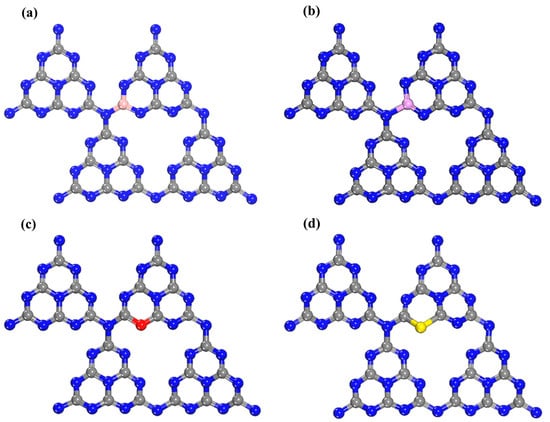
Figure 1.
The most stable structures of (a) B-C3N4, (b) P-C3N4, (c) O-C3N4, and (d) S-C3N4. The elements C, N, B, P, O, and S are represented by gray, blue, pink, purple, red, and yellow, respectively.
In pristine g-C3N4, the bond lengths of N1–C1, C1–N2, N2–C2, and C2–N3 measure 1.48, 1.34, 1.34, and 1.40 Å, respectively, consistent with other research [38,46]. The bond lengths of B–N, B–N1, and B–N2 are 1.43, 1.52, and 1.43 Å, respectively, while the bond lengths of P–N, P–N1, and P–N2 are 1.64, 1.75, and 1.65 Å, respectively. In the case of O-doped pristine g-C3N4, the O–C1 and O–C2 bond lengths are 1.42 and 1.36 Å, respectively, which agrees with a previous report [38]. For S-doped pristine g-C3N4, the S–C1 and S–C2 bond lengths are 1.81, and 1.77 Å, respectively. Moreover, the bond lengths in the non-metal-doped structure are greater than those in the pristine g-C3N4 structure, indicating a slight distortion in the heptazine unit. For the P replacement at the C1 site and S replacement at the N2 site, the larger atomic sizes of P and S compared to the atoms they replace cause them to protrude from the substrate, leading to the slight distortion of the local structure. This protrusion can impact the positive formation energies, in contrast, B-C3N4 and O-C3N4 are more seamlessly integrated into the substrate due to the smaller atomic sizes of B and O, which are closer to the sizes of the atoms they replace. This allows for their smoother integration into the lattice. The uniform incorporation of B and O results in less structural deformation, enhancing stability and preserving the desired properties of the pristine g-C3N4 substrate.
Additionally, the thermodynamic stability of all the catalysts was confirmed by ab initio molecular dynamics (AIMD) simulations at 300 K, as shown in Figure S2. All the catalysts demonstrate high thermodynamic stability. Although P-C3N4 and S-C3N4 exhibit slight deformation, they still maintain overall stability with positive formation energies. In summary, we assume that all our NM-C3N4 studies are also stable.
2.2. Electronic Properties of Pristine g-C3N4 and NM-C3N4
To elucidate the impact of non-metal doping on pristine g-C3N4, we calculated the electron localization function (ELF), charge density difference (CDD), density of states (DOS), and band gap of the NM-C3N4. The ELF analysis provides insights into the pristine and doped structures’ bonding nature and stabilization mechanisms. The ELF values range from 0 to 1, where 0 (blue) signifies electron delocalization and 1 (red) indicates strong localization. ELF values above 0.5 typically suggest covalent bonding or core electrons, while values below 0.5 indicate ionic bonds. An ELF value of 0.5 is associated with metallic bonds [47]. Our ELF analysis confirms the presence of covalent bonding between non-metal dopants and C or N atoms in g-C3N4, as shown in Figure S3. Notably, the non-metal atoms chemisorb onto the g-C3N4 framework, forming stable bonds. This finding aligns well with the stability analysis based on formation energy (Ef), despite the positive Ef observed for P-C3N4 and S-C3N4.
As illustrated in Figure S4, the charge density difference (CDD) analysis indicates that B and P atoms lose electrons. In contrast, O and S atoms gain electrons, producing distinct oxidation and reduction effects. B and P exhibit electron depletion, transferring 1.58e and 2.03e to the g-C3N4 surface (see Table 1). In contrast, O and S act as electron acceptors, with O gaining 0.76e and S gaining 0.05e. These charge redistribution trends reflect differences in electronegativity, classifying B and P as electron donors and O and S as electron acceptors.

Table 1.
Bond distances of B- or P-N1/N2 and O- or S-C1/C2 (D in Å), Bader charge analysis of Cu and C atoms (Q, in e), and band gaps with HSE06 (eV). Positive and negative charge values represent gained and lost electrons.
Furthermore, the total density of states (TDOS) and partial density of states (PDOS) of the pristine g-C3N4 and NM-C3N4 were calculated by the HSE06 function. As shown in Figure 2, the calculated band gap of pristine g-C3N4 is 3.06 eV, consistent with a previous theoretical study [40] and close to the experimental value of 2.70 eV [48]. For pristine g-C3N4, the PDOS analysis reveals that the valence band (VB) predominantly comprises N p-orbitals. In contrast, both C and N p-orbitals contribute to the conduction band (CB). The symmetric TDOS around the Fermi level indicates that the material is non-magnetic. A significant reduction in the band gap is observed upon doping with non-metal atoms (B, P, O, and S). The band gaps of B-C3N4, P-C3N4, O-C3N4, and S-C3N4 are reduced to 1.50 eV, 2.06 eV, 1.07 eV, and 1.14 eV, respectively. In the cases of B and P doping, the Fermi level shifts toward the valence band due to their donor-like behavior, which introduces shallow acceptor states. Conversely, O and S doping result in a Fermi level shift toward the conduction band, attributed to their acceptor-like nature. This change introduces mid-gap states and narrows the band gap, which is favorable for enhancing electronic conductivity and charge transfer. Additionally, the PDOS profiles show strong hybridization between the non-metal dopants and adjacent C or N atoms, as evidenced by overlapping peaks near the Fermi level. This hybridization indicates strong electronic coupling and improved charge delocalization in the doped systems. Notably, the appearance of pronounced peaks near the Fermi level in O-C3N4 and S-C3N4 suggests the presence of localized states that may act as active sites for CO2 adsorption and activation. The narrowed band gaps and the emergence of mid-gap states benefit the CO2 reduction reaction (CO2RR), as they can facilitate efficient charge carrier transport and enhance electrochemical activity. Moreover, the alignment of the Fermi level near the CB in O-C3N4 and S-C3N4 can promote electron transfer to adsorbed CO2 molecules, thereby facilitating the key reduction steps. Therefore, these doped g-C3N4 systems, particularly the O- and S-doped variants, are expected to exhibit improved electrocatalytic activity for CO2RR, correlating well with their predicted ability to generate valuable products such as HCOOH, CH2O, CH3OH, and CH4 at low overpotentials.
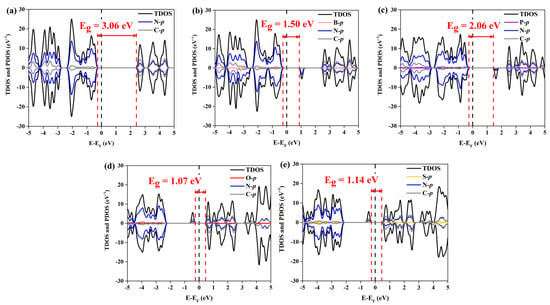
Figure 2.
The PDOS and energy gap (Eg) of (a) pristine g-C3N4, (b) B-C3N4, (c) P-C3N4, (d) O-C3N4, and (e) S-C3N4.
2.3. CO2 Adsorption on Pristine g-C3N4 and NM-C3N4
The initial step of electrocatalytic CO2 reduction involves the adsorption of CO2 onto catalyst surfaces. The potential adsorption sites for CO2 on the catalysts are illustrated in Figure S5. Firstly, as reported in Table S2, CO2 is adsorbed on surfaces with adsorption energies ranging from −0.15 to −0.38 eV. The most stable CO2 adsorption onto pristine g-C3N4, B-C3N4, P-C3N4, O-C3N4, and S-C3N4 is displayed in Figure 3. CO2 molecules are adsorbed on all surfaces with bond lengths of 2.97–3.26 Å. To further examine the adsorption mechanism, charge density difference analyses were conducted. Electron transfer from the catalyst surfaces to the CO2 molecules was observed, suggesting that NM doping enhances charge redistribution. This electron transfer could facilitate CO2 activation and promote subsequent electrochemical reduction, potentially improving CO2RR performance.

Figure 3.
Most stable CO2 adsorption structures and corresponding charge density differences for (a) pristine g-C3N4, (b) B-C3N4, (c) P-C3N4, (d) O-C3N4, and (e) S-C3N4. Yellow and blue isosurfaces (isosurface 0.0002 e/Bohr3) represent electron accumulation and depletion, respectively.
2.4. Electrocatalytic CO2 Reduction to C1 Products
The Gibbs free energy changes () for forming various C1 products were calculated to evaluate the efficiency of different reaction pathways in CO2RR. Figure 4 illustrates the reaction mechanisms leading to key C1 products, including CO, HCOOH, CH2O, CH3OH, and CH4, highlighting how CO2RR conditions can be optimized to yield specific products. We compared the of possible intermediates at each reduction step to identify the most favorable reaction pathways. This analysis revealed the energetically most favorable path to the target products. Furthermore, we compared each pathway’s maximum free energy change () corresponding to its potential-limiting step (PLS). Pathways with lower values were considered more selective [49,50], a crucial criterion for optimizing CO2RR processes and enhancing catalytic activity.
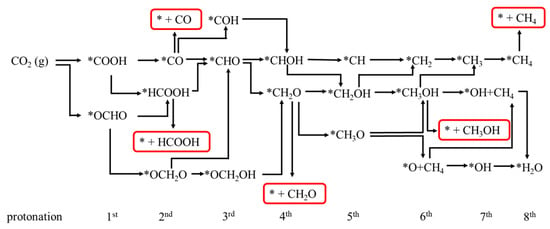
Figure 4.
Proposed reaction mechanisms for CO2RR via different proton–electron pathways: two-proton–electron path to form HCOOH, two-proton–electron path to CO, four-proton–electron path to CH2O, six-proton–electron path to CH3OH, and eight-proton–electron path to CH4.
2.4.1. First Protonation to HCOOH and CO
In the first protonation step, CO2 can be protonated at either the C or O site, forming formate (*OCHO) and carboxylate (*COOH) intermediates, respectively. Each intermediate can subsequently be protonated at either the C or O site, leading to the formation of other intermediates, as illustrated in Figure 4. Theoretically, the *OCHO or *COOH species can undergo further protonation to produce the final C1 product. We calculated the first protonation energies for both the *OCHO and *COOH intermediates to identify the most favorable pathway. Through a two-electron reduction process, CO2 can thereby be converted into either HCOOH or CO.
Figure 5 and Figure 6 illustrate the reaction pathways of CO2 reduction to HCOOH and the optimized structures of intermediates involved in HCOOH and CO production. For HCOOH, two potential pathways are identified: the COOH pathway (CO2 → *COOH → *HCOOH → HCOOH) and the OCHO pathway (CO2 → *OCHO → *HCOOH → HCOOH). The results indicate that the first protonation to form the *COOH intermediate requires a significantly lower compared to the *OCHO intermediate formation on both pristine g-C3N4 and S-doped C3N4, with values of 0.84 eV and 0.18 eV, respectively. In contrast, B-C3N4, P-C3N4 and O-C3N4 exhibit downhill trends in for *COOH formation. In the second protonation, the reaction from *COOH to *HCOOH on pristine g-C3N4 is also downhill, whereas B-C3N4, P-C3N4, O-C3N4, and S-C3N4 require values of 1.93, 0.73, 0.12, and 0.02 eV, respectively. These findings suggest that HCOOH production is more likely to proceed via the COOH pathway rather than the OCHO pathway, with the values for pristine g-C3N4, B-C3N4, P-C3N4, O-C3N4, and S-C3N4 being 0.84, 1.30, 1.93, 0.12, and 0.17 eV, respectively.
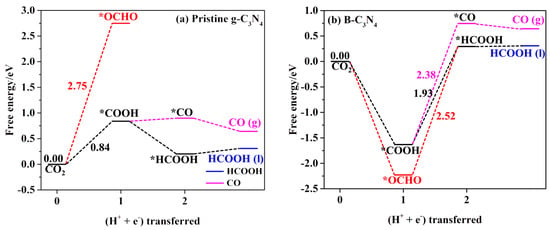
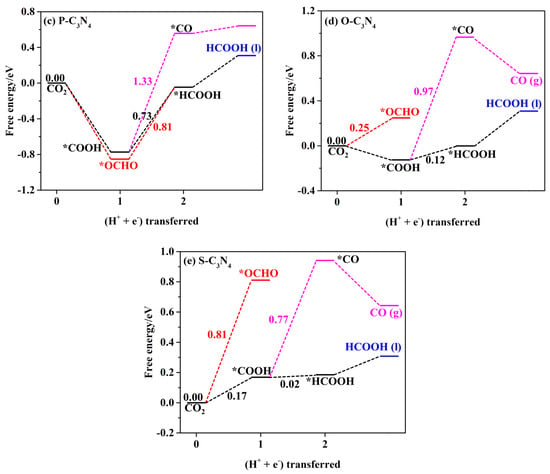
Figure 5.
Gibbs free energy profiles for CO2RR pathways to HCOOH via *OCHO intermediate (red line), HCOOH via *COOH intermediate (black line), and CO production (pink line) on (a) pristine g-C3N4, (b) B-C3N4, (c) P-C3N4, (d) O-C3N4, and (e) S-C3N4.
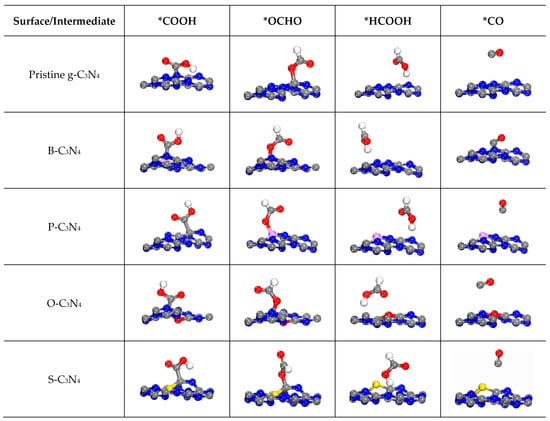
Figure 6.
Optimized intermediate structures along CO2RR toward HCOOH and CO production over pristine g-C3N4 and B-C3N4, P-C3N4, O-C3N4, and S-C3N4.
In the formation of CO through the CO2RR pathway, the sequence can be outlined as CO2 → *COOH → CO. The for the first protonation step (CO2 → *COOH) mirrors that in the HCOOH generation reaction. For the second protonation, the *COOH → *CO step requires values of 0.06, 2.38, 1.33, 0.97, and 0.77 eV for pristine g-C3N4, B-C3N4, P-C3N4, O-C3N4, and S-C3N4, respectively. Our results identify the PLS for CO production as the CO formation step, with values of 2.38, 1.33, 0.97, and 0.77 eV on B-C3N4, P-C3N4, O-C3N4, and S-C3N4, respectively, whereas for pristine g-C3N4, the first protonation step is the PLS. In evaluating the catalytic activity of each surface, we focus on the PLS for each pathway. Overall, the non-metal doping of pristine g-C3N4 decreases the of the first protonation step, enhancing CO2RR efficiency. Consequently, the two-electron CO2RR pathway favors HCOOH production via the COOH pathway over CO, with relatively low values observed across all surfaces.
2.4.2. The Other C1 Products for CO2RR
To elucidate the thermodynamic catalytic activity, we calculated the different CO2RR pathways for various C1 products on both pristine g-C3N4 and NM-C3N4. Detailed free energy diagrams for CO2RR on these materials are depicted in Figure 7. These diagrams provide insight into the energy changes associated with each step of the CO2RR process on these materials. The corresponding optimized structures for the favorable reaction pathways are presented in Figure 8.
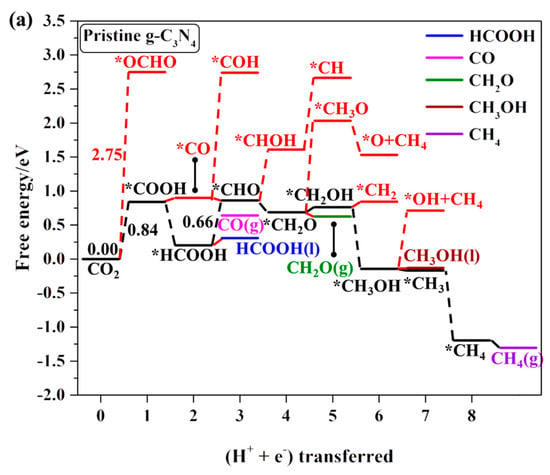
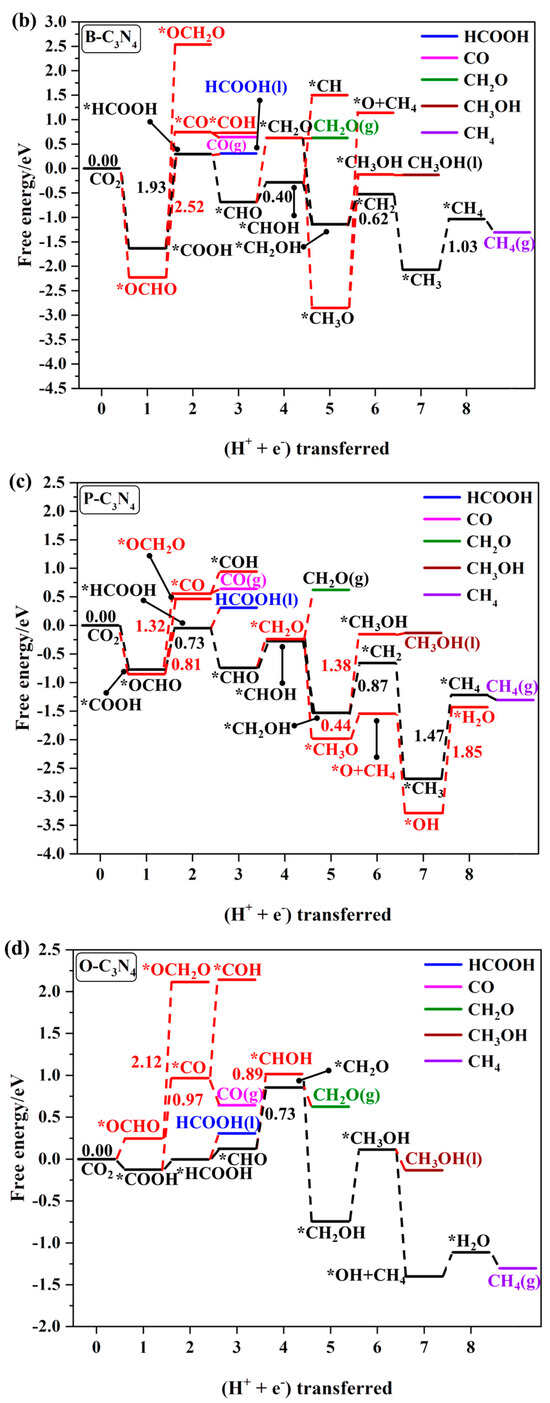
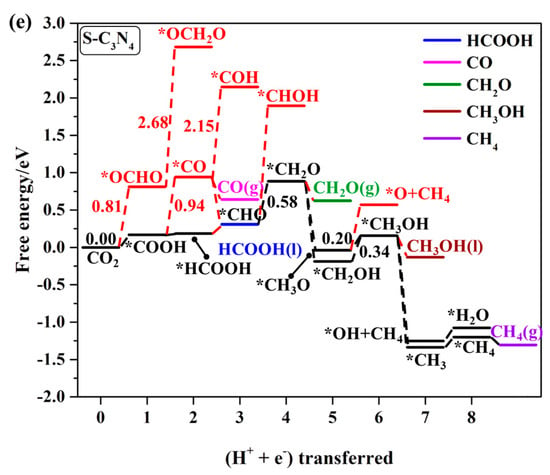
Figure 7.
Gibbs free energy diagrams for CO2RR toward C1 products on (a) pristine g-C3N4, (b) B-C3N4, (c) P-C3N4, (d) O-C3N4, and (e) S-C3N4 surfaces.
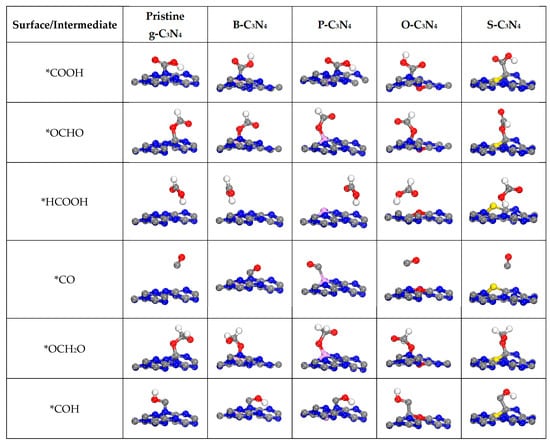
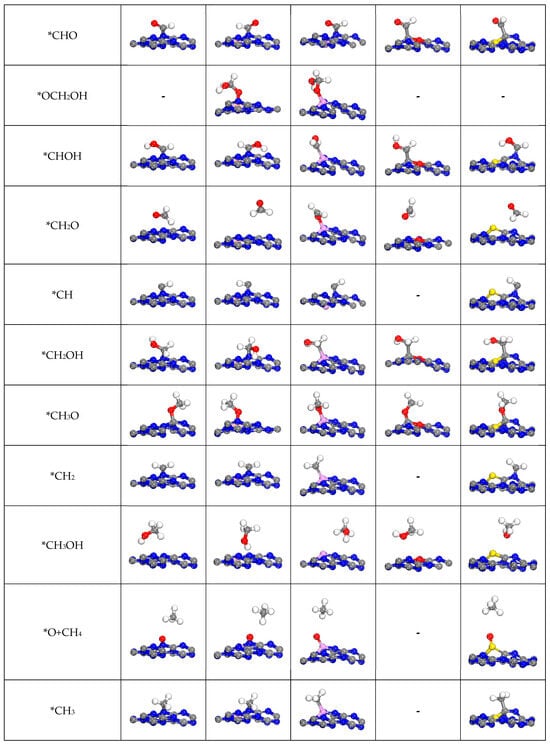
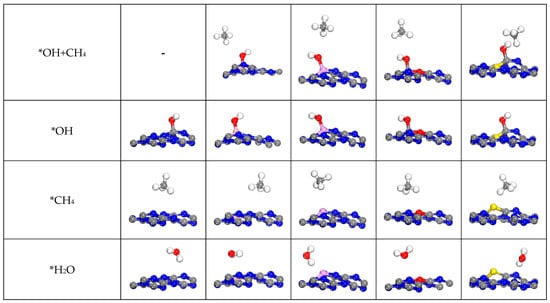
Figure 8.
Stable minimum states of intermediate species involved in CO2RR over pristine g-C3N4 and B-C3N4, P-C3N4, O-C3N4, and S-C3N4.
Figure 7a shows the Gibbs free energy profile for CO2RR on the pristine g-C3N4 surface. The initial step (CO2 → *COOH) is critical in determining the PLS for producing various C1 products, including HCOOH, CO, CH2O, CH3OH, and CH4, with a of 0.84 eV. The pathway for CH2O production is CO2 → *COOH → *HCOOH → *CHO → *CH2O, while CH3OH is formed through *CH2O → *CH2OH → *CH3OH, and CH4 proceeds via *CH3OH → *CH3 → *CH4. HCOOH is more favorable than other products due to its easier absorption from the catalyst surface.
In contrast, Figure 7b displays the Gibbs energy profile for B-C3N4, where the second protonation step, *COOH → *HCOOH, serves as the PLS for producing HCOOH, CH2O, CH3OH, and CH4, with a of 1.93 eV. The pathways for CH2O, CH3OH, and CH4 follow the sequences CO2 → *COOH → *HCOOH → *CHO → *CH2O, *CHO → *CHOH → *CH2OH → *CH3OH, and *CH2OH → *CH2 → *CH3 → *CH4, respectively. Although CH4 is thermodynamically favored due to its smaller free energy change, the high value limits the catalytic activity of B-C3N4, indicating a poor selectivity and limited effectiveness for CO2RR.
Figure 7c shows the Gibbs energy profile for P-C3N4, where HCOOH and CH2O are the primary products. The PLS for their production is CO2 → *COOH, with a of 0.73 eV, indicating the lowest . The preferred pathway for HCOOH production is CO2 → *COOH → *HCOOH, with a desorption energy of 0.35 eV. For CH2O, the pathway proceeds as CO2 → *COOH → *HCOOH → *CHO → *CH2O, with a desorption energy of 0.86 eV. Due to the difficulty in desorbing CH2O compared to the subsequent protonation step, P-C3N4 slightly disfavors CH2O production. The minor products CH3OH and CH4 have higher values of 1.38 and 1.47 eV, respectively, following the pathways CO2 → *COOH → *HCOOH → *CHO → *CHOH → *CH2OH → *CH3OH and CO2 → *COOH → *HCOOH → *CHO → *CHOH → *CH2OH → *CH2 → *CH3 → *CH4. The desorption energies for CH3OH and CH4 are 0.02 eV and −0.09 eV, respectively, suggesting the good selectivity of P-C3N4 for HCOOH production.
The Gibbs energy profile for O-C3N4 is shown in Figure 7d, where HCOOH emerges as the primary product, following the pathway CO2 → *COOH → *HCOOH. The PLS for HCOOH production is the *COOH → *HCOOH step, with a of 0.12 eV and a desorption energy of 0.31 eV. For minor products such as CH2O, CH3OH, and CH4, the corresponding pathways are CO2 → *COOH → *HCOOH → *CHO → *CH2O for CH2O, CO2 → *COOH → *HCOOH → *CHO → *CH2O → *CH2OH → *CH3OH for CH3OH, and CO2 → *COOH → *HCOOH → *CHO → *CH2O → *CH2OH → *CH3OH → *OH + CH4 → *H2O for CH4. Both pathways have a of 0.73 eV, with the PLS occurring at the *CHO → *CH2O step. The desorption energies are −0.23 eV for CH2O, −0.25 eV for CH3OH, and −0.01 eV for CH4, indicating favorable conditions for desorption. These findings suggest that O-C3N4 exhibits good selectivity and excellent catalytic activity for HCOOH production.
Finally, Figure 7e displays the Gibbs energy profile for S-C3N4, where HCOOH is the primary product along the CO2 → *COOH → *HCOOH pathway. The PLS for HCOOH formation is *COOH → *HCOOH, with a of 0.17 eV and a desorption energy of 0.12 eV. Either *HCOOH desorption or further protonation to generate *CHO occurs with the same energy. Therefore, the reaction proceeds from *CHO through successive proton–electron (H+ + e−) transfer steps, leading to the formation of CH2O, CH3OH, and CH4. It can be observed that, among the various intermediates in the CO2RR process, there is one pathway leading to the four-electron product CH2O, two pathways to form CH3OH, and four pathways to produce CH4. The most favorable pathways are as follows: The formation of CH2O proceeds via CO2 → *COOH → *HCOOH → *CHO → *CH2O. For CH3OH and CH4, the initial reduction steps follow the same sequence as CH2O formation, continuing along the pathways CO2 → *COOH → *HCOOH → *CHO → *CH2O → *CH2OH → *CH3OH and CO2 → *COOH → *HCOOH → *CHO → *CH2O → *CH2OH → *CH3OH → *CH3 → *CH4, respectively. The protonation step from *CHO to *CH2O is identified as the PLS for the formation of all three products, with a of 0.58 eV. The desorption energies are −0.26 eV for CH2O, −0.29 eV for CH3OH, and −0.23 eV for CH4, indicating that these products can be readily released from the surface. These results suggest that S-C3N4 exhibits a low for HCOOH production. Interestingly, S-C3N4 can also facilitate the formation of CH2O, CH3OH, and CH4, with a of 0.58 eV compared to just 0.17 eV for HCOOH.
While our DFT calculations focus on a fixed, low concentration of dopants (one non-metal atom per 2 × 2 supercell), the analysis captures the intrinsic catalytic behavior of each doped system. Notably, the dopant identity strongly influences the competition among various CO2RR pathways. For example, O-doping favors HCOOH formation via the *COOH pathway due to a low potential-limiting step ( = 0.12 eV), whereas S-doping facilitates deeper reduction pathways, enabling the formation of CH2O, CH3OH, and CH4 with a of 0.58 eV. These results reveal that dopant type governs activity, selectivity, and product distribution. We acknowledge that dopant concentration may further affect these trends by modulating surface electronic properties and active site density. However, a systematic investigation of varying dopant levels is beyond the scope of this work and will be explored in future studies. As supporting evidence, experimental work by Zhu et al. [51] demonstrated that CO2RR activity in S-C3N4 varied significantly with dopant concentration, with peak performance observed at a thiourea-to-dicyandiamide molar ratio of 0.4. This underscores the importance of future studies combining concentration effects with pathway analysis.
2.5. Competition Between CO2RR and HER on Pristine g-C3N4 and NM-C3N4
To evaluate catalytic activity and selectivity for CO2RR, it is essential to consider the competing hydrogen evolution reaction (HER). We investigated the free energy barriers of the HER based on the Volmer–Heyrovsky mechanism. Figure 9 and Figure S6 show the free energy diagram and optimized structure of H* adsorption on each surface. Our results showed that the HER occurs readily on pristine g-C3N4 with a of 0.04 eV, indicating a high tendency for HER and poor CO2RR selectivity. However, non-metal doping significantly alters this behavior, suppressing HER and enhancing the preference for the CO2RR pathway. Specifically, B-C3N4 and P-C3N4 exhibit greater thermodynamic favorabilities toward CO2RR over HERs. O-C3N4 and S-C3N4 also show a clear preference for CO2RR, particularly in producing HCOOH. The HER remains slightly more favorable regarding free energy under standard conditions for other C1 products (CO, CH2O, CH3OH, and CH4). However, in practical applications, HER can often be suppressed by tuning the pH or electrolyte composition [52].
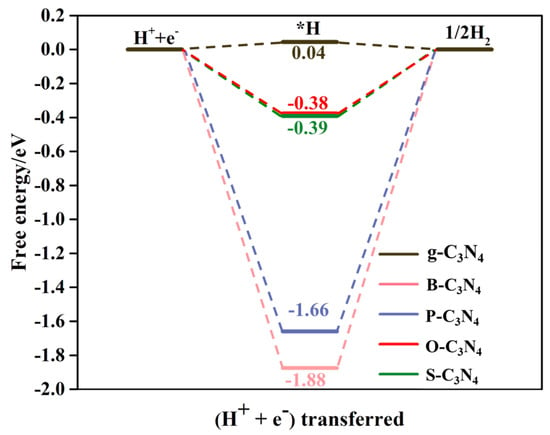
Figure 9.
Free energy diagram of HER on pristine g-C3N4, B-C3N4, P-C3N4, O-C3N4, and S-C3N4.
These findings confirm that non-metal doping effectively modulates the electronic structure and surface adsorption behavior of g-C3N4, thereby suppressing HER and improving CO2RR efficiency. Among the doped catalysts, S-C3N4 emerges as the most promising material for producing CH2O, CH3OH, and CH4, exhibiting a remarkably low limiting potential () of −0.58 V. This performance surpasses that of other non-metal-doped systems and rivals or exceeds certain metal-based catalysts. Additionally, O-C3N4 stands out for HCOOH production, achieving the lowest UL of −0.12 V, significantly outperforming previously reported systems such as Ni-C3N4 [26], Ag@g-C3N4 [53], and B-C3N [54]. This exceptional activity is attributed to its stabilizing of key reaction intermediates, such as *OCHO and *COOH, which lowers the energy barriers and promotes the selective formation of desired C1 products.
The comparative analysis of the limiting potentials of CO, HCOOH, CH2O, CH3OH, and CH4 on pristine and doped g-C3N4 systems, shown in Figure 10, highlights the critical role of dopants in product selectivity. The overall trend in product preference is as follows: HCOOH > CH2O, CH3OH, CH4 > CO. This confirms HCOOH as the most favored product, while CO is the least preferred.
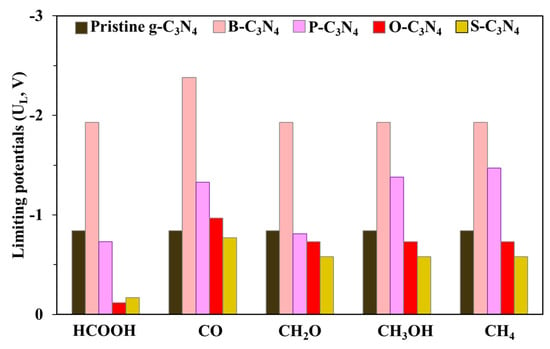
Figure 10.
Summary of limiting potentials for CO2RR toward formation of HCOOH, CO, CH2O, CH3OH, and CH4 on pristine C3N4 and B-C3N4, P-C3N4, O-C3N4, and S-C3N4.
The doped variants show significantly improved catalytic performance compared to pristine g-C3N4, which exhibits a relatively high limiting potential (−0.84 V) for the initial CO2 activation step (CO2 → *COOH). In particular, the P-, O-, and S-doped systems exhibit remarkably lower limiting potentials of −0.73 V, −0.12 V, and −0.17 V, respectively, for HCOOH production, indicating their enhanced activity and reduced energy barriers for CO2 reduction. These systems also promote the formation of valuable products such as CH2O, CH3OH, and CH4. While B-C3N4 also shows performance improvements and leads to diverse product distributions, it still requires higher overpotentials than its P-, O-, and S-doped counterparts. Among all the systems investigated, non-metal dopants, especially O- and S-, exhibit remarkably low limiting potentials and support the formation of various valuable reduction products. As summarized in Table 2, our O- and S-doped g-C3N4 surfaces exhibit superior activity, with notably low limiting potentials of −0.12 V and −0.58 V, respectively. These values not only improve upon pristine g-C3N4 (−0.84 V) but also outperform several reported systems. These comparisons indicate that our designed O- and S-doped g-C3N4 catalysts offer compelling combinations of low energy barriers, favorable selectivity, and scalable non-metal synthesis, reinforcing their promise for CO2RR applications. This highlights the potential of non-metal-doped g-C3N4, which is promising due to its high activity at low overpotentials and its environmentally benign and sustainable nature. Unlike metal-based catalysts, which may face cost, scarcity, and toxicity challenges, non-metal-doped systems offer a green alternative without compromising performance.

Table 2.
Comparison of PLS, limiting potential (), and product of CO2RR with previously reported catalysts.
To further evaluate catalytic performance and mechanistic trends, we constructed volcano plots (Figure 11) correlating the limiting potential () for HCOOH and CH4 production with the free energy difference (*COOH) − (CO2). These plots reflect the Sabatier principle, which posits that optimal catalysts exhibit an intermediate binding strength for key intermediates, neither too weak, leading to poor activation, nor too strong, resulting in high energy barriers for product formation or desorption. In this analysis, O-C3N4 and S-C3N4 surfaces are positioned at the top and middle of the curve, demonstrating a favorable balance between activity and stability. Catalysts positioned in this region are more likely to facilitate efficient CO2RR. Notably, O-C3N4 favors HCOOH formation, while S-doping promotes CH4 generation, consistent with their respective mechanistic pathways.
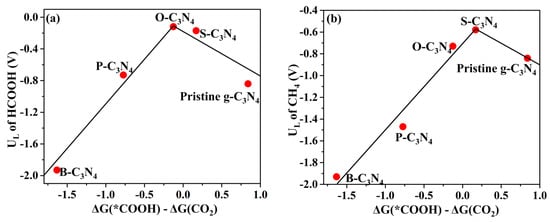
Figure 11.
A volcano plot of the *COOH intermediate as a function of the of (a) HCOOH and (b) CH4.
To understand the electronic basis for this trend, we further analyzed the *COOH and *OCHO intermediates using ICOHP and PDOS methods, as shown in Figure 12. Interestingly, *OCHO exhibits more negative ICOHP values than *COOH (e.g., −4.73 eV vs. −4.21 eV on O-C3N4), indicating stronger orbital overlap. However, this strong binding may hinder further protonation and raise the reaction barrier. In contrast, *COOH exhibits moderately strong bonding, sufficient to activate CO2 but not so strong as to prevent desorption or subsequent transformation. These insights align well with the observed thermodynamic profiles, which show lower and limiting potential for *COOH-mediated pathways. The PDOS results further confirm that *COOH forms well-hybridized states with dopant orbitals, facilitating charge transfer and enhancing reactivity. The volcano plot and bonding analysis provide a unified explanation for the superior CO2RR activity observed on O-C3N4 and S-C3N4. Their position near the volcano apex and favorable intermediate bonding characteristics highlight their potential as highly efficient, metal-free catalysts for selective CO2 conversion.
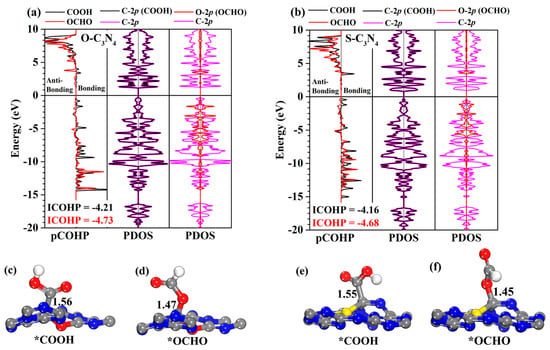
Figure 12.
The integrated crystal orbital Hamilton population (ICOHP) on the (a) O–C3N4 and (b) S–C3N4 surfaces, and the partial density of states (PDOS) for the *OCHO and *COOH intermediates on (c,e) O–C3N4 and (d,f) S–C3N4 surfaces, respectively.
Although this study evaluates non-metal-doped g-C3N4 at a single dopant concentration, the observed trends in limiting potential and product selectivity reflect the intrinsic effects of dopant identity. Our findings underscore the distinct catalytic roles of each dopant, with O promoting selective HCOOH production and S facilitating deeper reduction to CH4. These outcomes provide predictive guidance for tuning product distribution via rational doping strategies. Future work will extend this framework to explore dopant concentration effects, which have been shown experimentally to significantly influence photocatalytic CO2 reduction performance in g-C3N4 systems.
3. Methodology
3.1. Computational Details
Firstly, all the spin-polarized density functional theory (DFT) calculations were performed using the Perdew–Burke–Ernzerhof (PBE) generalized gradient approximation exchange–correlation function [57] and the projector augmented wave (PAW) [58] method via the Vienna ab initio Simulation Package code. (VASP) [59]. Grimme’s dispersion correction (DFT-D3) [60] described the van der Waals interaction. The cutoff energy of the plane–wave basis was set to 450 eV. The forces and electronic energy were converged to within 0.02 eV/Å and 1 × 10−6 eV, respectively. Accordingly, the k-point was set to a 3 × 3 × 1 Monkhorst–Pack mesh for geometry optimizations. After geometry optimization, the HSE06 hybrid function [61,62] was used to refine the electronic properties. Ab initio molecular dynamics (AIMD) simulations were performed to assess the thermal stability of the surfaces.
3.2. Structural Model and Stability Assessment
The pristine g-C3N4 structure was modeled as a 2 × 2 supercell with 32 N atoms and 24 C atoms, cleaved along the (001) plane as shown in Figure 13. A vacuum layer of 15 Å was introduced to prevent interactions between periodic images. The lattice constant of the surface after geometry optimization was a = b = 14.24 Å, which was consistent with previous computational and experimental studies [63,64,65].
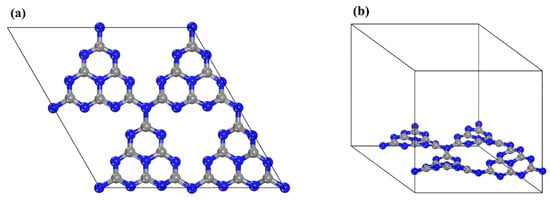
Figure 13.
Optimized structure of pristine g-C3N4 viewed from (a) top and (b) side perspectives. Carbon (C) and nitrogen (N) atoms represented by gray and blue spheres, respectively.
To assess the stability of the non-metal atoms (B, P, O, and S) substituted into the pristine g-C3N4, the defect formation energies for replacing a nitrogen atom or carbon atom (1) and for the interstitial dopants (2) were calculated using the following equations:
where is the total energy of the non-metal substitution into the pristine g-C3N4 and is the total energy of the pristine g-C3N4. , , and are the chemical potentials of the non-metals, N, and C atom, respectively. , , , , , and are determined as follows: is defined as half of the energy of an N2 molecule in the gas phase, as the energy of a single carbon atom in pristine graphene, as the energy of a single boron atom in the metallic α-B phase [66], as the energy of a single phosphorus atom in P4 [27], as half of the energy of an O2 molecule in the gas phase, and as the energy of a single sulfur atom in S8 [67]. A negative predicted that the formation of all the non-metal doped systems would be more stable and spontaneous. Moreover, the adsorption energies of the gas molecules on the surfaces were calculated by the following equation:
where , , and are the total energy of the molecules adsorbed on the monolayer, the bare monolayer, and isolated molecules, respectively. Herein, a more negative value indicates more stable gas adsorption.
Reaction pathways were analyzed using Gibbs free energy (ΔG) corrections based on the computational hydrogen electrode (CHE) model [68], which is described as follows:
where , , , , and represent the total electronic energy, zero-point energy, entropy correction, enthalpic temperature correction, and solvent effect correction, respectively. is the temperature, which was set to 298.15 K in this work. These corrections were obtained from vibrational frequency calculations. The value depends on the hydroxy group (OH) binding configuration. In this study, we used an of −0.20 eV when the intermediate had its OH group directly bound to the surface, and of −0.10 eV when the intermediate had an OH group indirectly bound to the surface [69].
The free energy change between the intermediate states was calculated by the following equation:
where , , , and represent the electronic energy difference between the two intermediate states, the change in zero-point energies, the entropic corrections, and the change in solvent effect correction, respectively. and are the change in the pH of the solution and the difference in electrode potential of the electrochemical reaction, respectively. Herein, , where and are the Boltzmann constant and of the reaction condition, respectively. In this work, we assumed that pH = 0; thus, . Moreover, , where , and are the number of transferred electrons, the electron charge, and the applied external potential, respectively. If there was no applied potential in the reaction, then [70,71].
Additionally, the limiting potential represented the minimum applied potential that would make every elementary step exergonic, which could be obtained by the following equation:
where is the of a potential-limiting step (PLS) in the CO2RR pathway.
4. Conclusions
We employed density functional theory (DFT) to investigate the CO2 reduction reaction (CO2RR) mechanisms on pristine and non-metal-doped g-C3N4 systems, incorporating B, P, O, and S dopants. Our results reveal that the dopant type and its substitutional site strongly influence catalytic activity and product selectivity. The *COOH intermediate plays a crucial role in C1 product formation, with O-doped g-C3N4 (O-C3N4) showing outstanding performance for HCOOH production at a low limiting potential of −0.12 V. In contrast, S-doped g-C3N4 (S-C3N4) exhibits high selectivity for CH2O, CH3OH, and CH4 formation at −0.58 V, and CO at −0.77 V, underlining its versatility for multi-product CO2RR. Beyond their catalytic efficiency, NM-doped g-C3N4 materials offer notable advantages in cost-effectiveness and environmental sustainability compared to traditional metal-based catalysts. Among the materials studied, O-C3N4 and S-C3N4 emerge as particularly promising, combining high activity and selectivity with the benefits of sustainable, metal-free catalysis for carbon dioxide conversion.
Supplementary Materials
The following supporting information can be downloaded at: https://www.mdpi.com/article/10.3390/catal15060553/s1, Figure S1: Top side view of the optimized geometric structure of pristine g-C3N4. The top view also illustrates the possible doping sites considered in this study, labeled as N1, N2, N3, C1, C2, and int.; Figure S2: Temperature variations versus the AIMD simulation time for pristine g-C3N4, B-C3N4, P-C3N4, O-C3N4, and S-C3N4.; Figure S3: The electron localization function (ELF) of pristine g-C3N4, B-C3N4, P-C3N4, O-C3N4, and S-C3N4.; Figure S4: The charge density differences (CDD) plots of B-C3N4, P-C3N4, O-C3N4, and S-C3N4; Figure S5: The possible CO2 adsorption sites on pristine g-C3N4, B-C3N4, P-C3N4, O-C3N4, and S-C3N4.; Figure S6: The most stable structures of intermediates HER of pristine g-C3N4, B-C3N4, P-C3N4, O-C3N4, and S-C3N4.; Table S1: Formation energies (eV) of NM-C3N4 systems with various doping sites.; Table S2: CO2 adsorption energies (Eads) and bond lengths of C or O of CO2 on each surface.
Author Contributions
S.N. and S.J. conceptualized the research. S.N. and K.T. designed the computational methodology. W.M. performed the DFT calculations, conducted data analysis, and wrote the original draft. Y.I. collected data, performed formal analysis, and reviewed and edited the manuscript. N.Y. performed formal analysis. S.N. and S.J. supervised the project, contributed to the results discussion, and reviewed and edited the manuscript. All authors have read and agreed to the published version of the manuscript.
Funding
The research was funded by the NSRF via the Program Management Unit for Human Resources & Institutional Development, Research and Innovation, grant number B16F640099.
Data Availability Statement
The data presented in this study are available on request from the corresponding author. The data are not publicly available due to privacy.
Acknowledgments
This research project was supported by the Thailand Graduate Institute of Science and Technology (TGIST, contract no. SCA-CO-2565-17182-TH) and the National Science, Research, and Innovation Fund. The authors gratefully acknowledge the NSRF via the Program Management Unit for Human Resources & Institutional Development, Research and Innovation [B16F640099]. The NSTDA Supercomputer Center (ThaiSC) provided computational resources. The authors also thank the Center of Excellence for Innovation in Chemistry (PERCH-CIC), in the Department of Chemistry, Faculty of Science, Ubon Ratchathani University, for their support.
Conflicts of Interest
The authors declare that they have no known competing financial interests or personal relationships that could have appeared to influence the work reported in this paper.
References
- Pan, F.; Zhao, H.; Deng, W.; Feng, X.; Li, Y. A novel N,Fe-Decorated carbon nanotube/carbon nanosheet architecture for efficient CO2 reduction. Electrochim. Acta 2018, 273, 154–161. [Google Scholar] [CrossRef]
- Li, Y.; Sun, Q. Recent Advances in Breaking Scaling Relations for Effective Electrochemical Conversion of CO2. Adv. Energy Mater. 2016, 6, 1600463. [Google Scholar] [CrossRef]
- Aresta, M.; Dibenedetto, A. Utilisation of CO2 as a chemical feedstock: Opportunities and challenges. Dalton Trans. 2007, 2975–2992. [Google Scholar] [CrossRef]
- Liang, S.; Altaf, N.; Huang, L.; Gao, Y.; Wang, Q. Electrolytic cell design for electrochemical CO2 reduction. J. CO2 Util. 2020, 35, 90–105. [Google Scholar] [CrossRef]
- Yang, Z.; Nie, H.; Chen, X.; Chen, X.; Huang, S. Recent progress in doped carbon nanomaterials as effective cathode catalysts for fuel cell oxygen reduction reaction. J. Power Sources 2013, 236, 238–249. [Google Scholar] [CrossRef]
- Zhao, Z.; Li, M.; Zhang, L.; Dai, L.; Xia, Z. Design principles for heteroatom-doped carbon nanomaterials as highly efficient catalysts for fuel cells and metal–air batteries. Adv. Mater. 2015, 27, 6834–6840. [Google Scholar] [CrossRef]
- Hu, C.; Dai, L. Doping of Carbon Materials for Metal-Free Electrocatalysis. Adv. Mater. 2019, 31, 1804672. [Google Scholar] [CrossRef]
- Meng, N.; Zhou, W.; Yu, Y.; Liu, Y.; Zhang, B. Superficial Hydroxyl and Amino Groups Synergistically Active Polymeric Carbon Nitride for CO2 Electroreduction. ACS Catal. 2019, 9, 10983–10989. [Google Scholar] [CrossRef]
- Liu, C.; Tian, A.; Li, Q.; Wang, T.; Qin, G.; Li, S.; Sun, C. 2D, Metal-Free Electrocatalysts for the Nitrogen Reduction Reaction. Adv. Funct. Mater. 2023, 33, 2210759. [Google Scholar] [CrossRef]
- Wang, X.; Yu, M.; Feng, X. Electronic structure regulation of noble metal-free materials toward alkaline oxygen electrocatalysis. eScience 2023, 3, 100141. [Google Scholar] [CrossRef]
- Lu, X.; Tan, T.H.; Ng, Y.H.; Amal, R. Highly Selective and Stable Reduction of CO2 to CO by a Graphitic Carbon Nitride/Carbon Nanotube Composite Electrocatalyst. Chem.—Eur. J. 2016, 22, 11991–11996. [Google Scholar] [CrossRef] [PubMed]
- Si, Y.; Zhang, Y.; Lu, L.; Zhang, S.; Chen, Y.; Liu, J.; Jin, H.; Hou, S.; Dai, K.; Song, W. Boosting visible light photocatalytic hydrogen evolution of graphitic carbon nitride via enhancing it interfacial redox activity with cobalt/nitrogen doped tubular graphitic carbon. Appl. Catal. B Environ. 2018, 225, 512–518. [Google Scholar] [CrossRef]
- Al-Ahmed, A. Photocatalytic properties of graphitic carbon nitrides (g-C3N4) for sustainable green hydrogen production: Recent advancement. Fuel 2022, 316, 123381. [Google Scholar] [CrossRef]
- Liu, Y.; Cao, X.; Zhang, S.; Cao, J.; Zhang, A.; Zhang, S.; Su, P.; Ai, Y. High-efficiency and selective capture of nitric oxide by fluorine-modified carbon nitride: A DFT investigation. Appl. Surf. Sci. 2022, 593, 153353. [Google Scholar] [CrossRef]
- Zhou, Y.; Zhang, L.; Huang, W.; Kong, Q.; Fan, X.; Wang, M.; Shi, J. N-doped graphitic carbon-incorporated g-C3N4 for remarkably enhanced photocatalytic H2 evolution under visible light. Carbon 2016, 99, 111–117. [Google Scholar] [CrossRef]
- Kumar, S.; Karthikeyan, S.; Lee, A.F. g-C3N4-Based Nanomaterials for Visible Light-Driven Photocatalysis. Catalysts 2018, 8, 74. [Google Scholar] [CrossRef]
- Ismael, M. A review on graphitic carbon nitride (g-C3N4) based nanocomposites: Synthesis, categories, and their application in photocatalysis. J. Alloys Compd. 2020, 846, 156446. [Google Scholar] [CrossRef]
- Gu, Y.; Li, S.; Li, M.; Wang, X.; Liu, Y.; Shi, K.; Bai, X.; Yao, Q.; Wu, Z.; Yao, H. Recent advances in g-C3N4-based photo-enzyme catalysts for degrading organic pollutants. RSC Adv. 2023, 13, 937–947. [Google Scholar] [CrossRef]
- Mao, X.; Guo, R.; Chen, Q.; Zhu, H.; Li, H.; Yan, Z.; Guo, Z.; Wu, T. Recent Advances in Graphitic Carbon Nitride Based Electro-Catalysts for CO2 Reduction Reactions. Molecules 2023, 28, 3292. [Google Scholar] [CrossRef] [PubMed]
- Yurova, V.Y.; Potapenko, K.O.; Aliev, T.A.; Kozlova, E.A.; Skorb, E.V. Optimization of g-C3N4 synthesis parameters based on machine learning to predict the efficiency of photocatalytic hydrogen production. Int. J. Hydrogen Energy 2024, 81, 193–203. [Google Scholar] [CrossRef]
- Kharina, S.; Kurenkova, A.; Aydakov, E.; Mishchenko, D.; Gerasimov, E.; Saraev, A.; Zhurenok, A.; Lomakina, V.; Kozlova, E. Activation of g-C3N4 by oxidative treatment for enhanced photocatalytic H2 evolution. Appl. Surf. Sci. 2025, 698, 163074. [Google Scholar] [CrossRef]
- Vasilchenko, D.; Zhurenok, A.; Saraev, A.; Gerasimov, E.; Cherepanova, S.; Tkachev, S.; Plusnin, P.; Kozlova, E. Highly efficient hydrogen production under visible light over g-C3N4-based photocatalysts with low platinum content. Chem. Eng. J. 2022, 445, 136721. [Google Scholar] [CrossRef]
- Gao, G.; Jiao, Y.; Waclawik, E.R.; Du, A. Single Atom (Pd/Pt) Supported on Graphitic Carbon Nitride as an Efficient Photocatalyst for Visible-Light Reduction of Carbon Dioxide. J. Am. Chem. Soc. 2016, 138, 6292–6297. [Google Scholar] [CrossRef] [PubMed]
- Jiao, Y.; Zheng, Y.; Chen, P.; Jaroniec, M.; Qiao, S.-Z. Molecular Scaffolding Strategy with Synergistic Active Centers to Facilitate Electrocatalytic CO2 Reduction to Hydrocarbon/Alcohol. J. Am. Chem. Soc. 2017, 139, 18093–18100. [Google Scholar] [CrossRef]
- Zhang, L.; Mao, F.; Zheng, L.R.; Wang, H.F.; Yang, X.H.; Yang, H.G. Tuning Metal Catalyst with Metal–C3N4 Interaction for Efficient CO2 Electroreduction. ACS Catal. 2018, 8, 11035–11041. [Google Scholar] [CrossRef]
- Guo, C.; Zhang, T.; Deng, X.; Liang, X.; Guo, W.; Lu, X.; Wu, C.-M.L. Electrochemical CO2 Reduction to C1 Products on Single Nickel/Cobalt/Iron-Doped Graphitic Carbon Nitride: A DFT Study. ChemSusChem 2019, 12, 5126–5132. [Google Scholar] [CrossRef]
- Ranjbakhsh, E.; Izadyar, M.; Nakhaeipour, A.; Habibi-Yangjeh, A. P-doped g-C3N4 as an efficient photocatalyst for CO2 conversion into value-added materials: A joint experimental and theoretical study. Int. J. Quantum Chem. 2020, 120, e26388. [Google Scholar] [CrossRef]
- Gao, D.; Liu, Y.; Liu, P.; Si, M.; Xue, D. Atomically Thin B doped g-C3N4 Nanosheets: High-Temperature Ferromagnetism and calculated Half-Metallicity. Sci. Rep. 2016, 6, 35768. [Google Scholar] [CrossRef]
- Li, X.; Zhu, P.; Liu, C.; Pang, H. One step synthesis of boron-doped carbon nitride derived from 4-pyridylboronic acid as biosensing platforms for assessment of food safety. Chem. Commun. 2019, 55, 9160–9163. [Google Scholar] [CrossRef] [PubMed]
- Su, C.; Zhou, Y.; Zhang, L.; Yu, X.; Gao, S.; Sun, X.; Cheng, C.; Liu, Q.; Yang, J. Enhanced n→π* electron transition of porous P-doped g-C3N4 nanosheets for improved photocatalytic H2 evolution performance. Ceram. Int. 2020, 46, 8444–8451. [Google Scholar] [CrossRef]
- Liu, G.; Niu, P.; Sun, C.; Smith, S.C.; Chen, Z.; Lu, G.Q.; Cheng, H.-M. Unique Electronic Structure Induced High Photoreactivity of Sulfur-Doped Graphitic C3N4. J. Am. Chem. Soc. 2010, 132, 11642–11648. [Google Scholar] [CrossRef] [PubMed]
- Sakthivel, A.; Chandrasekaran, A.; Jayakumar, S.; Manickam, P.; Alwarappan, S. Sulphur Doped Graphitic Carbon Nitride as an Efficient Electrochemical Platform for the Detection of Acetaminophen. J. Electrochem. Soc. 2019, 166, B1461. [Google Scholar] [CrossRef]
- Qin, H.; Lv, W.; Bai, J.; Zhou, Y.; Wen, Y.; He, Q.; Tang, J.; Wang, L.; Zhou, Q. Sulfur-doped porous graphitic carbon nitride heterojunction hybrids for enhanced photocatalytic H2 evolution. J. Mater. Sci. 2019, 54, 4811–4820. [Google Scholar] [CrossRef]
- Hussain, A.; Ali, N.; Ali, S.S.; Hou, J.; Aslam, I.; Naeem, H.; Boota, M.; Ul-Hussan, M.; Yin, J.; Wang, X. Diverse morphological study for nonmetal-doped g-C3N4 composites with narrow bandgap for improved photocatalytic activity. Res. Chem. Intermed. 2022, 48, 2857–2870. [Google Scholar] [CrossRef]
- Hu, S.; Ma, L.; You, J.; Li, F.; Fan, Z.; Wang, F.; Liu, D.; Gui, J. A simple and efficient method to prepare a phosphorus modified g-C3N4 visible light photocatalyst. RSC Adv. 2014, 4, 21657–21663. [Google Scholar] [CrossRef]
- Huang, Z.-F.; Song, J.; Pan, L.; Wang, Z.; Zhang, X.; Zou, J.-J.; Mi, W.; Zhang, X.; Wang, L. Carbon nitride with simultaneous porous network and O-doping for efficient solar-energy-driven hydrogen evolution. Nano Energy 2015, 12, 646–656. [Google Scholar] [CrossRef]
- Chen, G.; Gao, S.-P. Structure and electronic structure of S-doped graphitic C3N4 investigated by density functional theory. Chin. Phys. B 2012, 21, 107101. [Google Scholar] [CrossRef]
- Cui, J.; Liang, S.; Wang, X.; Zhang, J. First principle modeling of oxygen-doped monolayer graphitic carbon nitride. Mater. Chem. Phys. 2015, 161, 194–200. [Google Scholar] [CrossRef]
- Sun, F.-l.; Fang, Q.-j.; Yu, Y.-f.; Zhang, W.; Pan, J.-k.; Chen, W.-X.; Zhuang, G.-l. Enhancing mechanism of electron-deficient p states on photocatalytic activity of g-C3N4 for CO2 reduction. J. Mater. Chem. A 2022, 10, 9565–9574. [Google Scholar] [CrossRef]
- Wei, B.; Wang, W.; Sun, J.; Mei, Q.; An, Z.; Cao, H.; Han, D.; Xie, J.; Zhan, J.; He, M. Insight into the effect of boron doping on electronic structure, photocatalytic and adsorption performance of g-C3N4 by first-principles study. Appl. Surf. Sci. 2020, 511, 145549. [Google Scholar] [CrossRef]
- Zhu, Y.; Zhang, D.; Gong, L.; Zhang, L.; Xia, Z. Catalytic Activity Origin and Design Principles of Graphitic Carbon Nitride Electrocatalysts for Hydrogen Evolution. Front. Mater. 2019, 6, 16. [Google Scholar] [CrossRef]
- Lu, S.; Li, C.; Li, H.H.; Zhao, Y.F.; Gong, Y.Y.; Niu, L.Y.; Liu, X.J.; Wang, T. The effects of nonmetal dopants on the electronic, optical and chemical performances of monolayer g–C3N4 by first-principles study. Appl. Surf. Sci. 2017, 392, 966–974. [Google Scholar] [CrossRef]
- Fu, J.; Zhu, B.; Jiang, C.; Cheng, B.; You, W.; Yu, J. Hierarchical Porous O-Doped g-C3N4 with Enhanced Photocatalytic CO2 Reduction Activity. Small 2017, 13, 1603938. [Google Scholar] [CrossRef]
- Wang, Y.; Tian, Y.; Yan, L.; Su, Z. DFT Study on Sulfur-Doped g-C3N4 Nanosheets as a Photocatalyst for CO2 Reduction Reaction. J. Phys. Chem. C 2018, 122, 7712–7719. [Google Scholar] [CrossRef]
- Arumugam, M.; Tahir, M.; Praserthdam, P. Effect of nonmetals (B, O, P, and S) doped with porous g-C3N4 for improved electron transfer towards photocatalytic CO2 reduction with water into CH4. Chemosphere 2022, 286, 131765. [Google Scholar] [CrossRef] [PubMed]
- Aspera, S.M.; David, M.; Kasai, H. First-Principles Study of the Adsorption of Water on Tri-s-triazine-based Graphitic Carbon Nitride. Jpn. J. Appl. Phys. 2010, 49, 115703. [Google Scholar] [CrossRef]
- Yu, Y.; Guo, Z.; Peng, Q.; Zhou, J.; Sun, Z. Novel two-dimensional molybdenum carbides as high capacity anodes for lithium/sodium-ion batteries. J. Mater. Chem. A 2019, 7, 12145–12153. [Google Scholar] [CrossRef]
- Wang, X.; Maeda, K.; Thomas, A.; Takanabe, K.; Xin, G.; Carlsson, J.M.; Domen, K.; Antonietti, M. A metal-free polymeric photocatalyst for hydrogen production from water under visible light. Nat. Mater. 2009, 8, 76–80. [Google Scholar] [CrossRef]
- Back, S.; Jung, Y. TiC- and TiN-Supported Single-Atom Catalysts for Dramatic Improvements in CO2 Electrochemical Reduction to CH4. ACS Energy Lett. 2017, 2, 969–975. [Google Scholar] [CrossRef]
- Back, S.; Lim, J.; Kim, N.-Y.; Kim, Y.-H.; Jung, Y. Single-atom catalysts for CO2 electroreduction with significant activity and selectivity improvements. Chem. Sci. 2017, 8, 1090–1096. [Google Scholar] [CrossRef]
- Zhu, Z.; Liu, Z.; Tang, X.; Reeti, K.; Huo, P.; Wong, J.W.-C.; Zhao, J. Sulfur-doped g-C3N4 for efficient photocatalytic CO2 reduction: Insights by experiment and first-principles calculations. Catal. Sci. Technol. 2021, 11, 1725–1736. [Google Scholar] [CrossRef]
- Hori, Y. Electrochemical CO2 Reduction on Metal Electrodes. In Modern Aspects of Electrochemistry; Vayenas, C.G., White, R.E., Gamboa-Aldeco, M.E., Eds.; Springer: New York, NY, USA, 2008; pp. 89–189. [Google Scholar]
- Posada-Pérez, S.; Vidal-López, A.; Solà, M.; Poater, A. 2D carbon nitride as a support with single Cu, Ag, and Au atoms for carbon dioxide reduction reaction. Phys. Chem. Chem. Phys. 2023, 25, 8574–8582. [Google Scholar] [CrossRef] [PubMed]
- Zhao, T.; Tian, Y.; Yan, L.; Su, Z. Heteroatom-doped C3N as a promising metal-free catalyst for a high-efficiency carbon dioxide reduction reaction. New J. Chem. 2020, 44, 11824–11828. [Google Scholar] [CrossRef]
- Liu, Y.; Li, J.; Cao, X.; Wei, X.; Cao, J.; Lin, K.; Zhou, Y.; Ai, Y. Hydrogenated Si-doped g-C3N4: Promising electrocatalyst for CO2 capture and conversion. Appl. Surf. Sci. 2023, 614, 156195. [Google Scholar] [CrossRef]
- Fu, G.; Zhen, W.; Wang, H.; Zhou, X.; Yang, L.; Zhang, J. Potassium and Boron Co-Doping of g-C3N4 Tuned CO2 Reduction Mechanism for Enhanced Photocatalytic Performance: A First-Principles Investigation. Molecules 2024, 29, 5339. [Google Scholar] [CrossRef]
- Perdew, J.P.; Burke, K.; Ernzerhof, M. Generalized Gradient Approximation Made Simple. Phys. Rev. Lett. 1996, 77, 3865–3868. [Google Scholar] [CrossRef]
- Blöchl, P.E. Projector augmented-wave method. Phys. Rev. B 1994, 50, 17953–17979. [Google Scholar] [CrossRef]
- Kresse, G.; Furthmüller, J. Efficient iterative schemes for ab initio total-energy calculations using a plane-wave basis set. Phys. Rev. B 1996, 54, 11169–11186. [Google Scholar] [CrossRef]
- Grimme, S.; Antony, J.; Ehrlich, S.; Krieg, H. A consistent and accurate ab initio parametrization of density functional dispersion correction (DFT-D) for the 94 elements H-Pu. J. Chem. Phys. 2010, 132, 154104. [Google Scholar] [CrossRef]
- Heyd, J.; Scuseria, G.E.; Ernzerhof, M. Hybrid functionals based on a screened Coulomb potential. J. Chem. Phys. 2003, 118, 8207–8215. [Google Scholar] [CrossRef]
- Heyd, J.; Scuseria, G.E. Efficient hybrid density functional calculations in solids: Assessment of the Heyd–Scuseria–Ernzerhof screened Coulomb hybrid functional. J. Chem. Phys. 2004, 121, 1187–1192. [Google Scholar] [CrossRef] [PubMed]
- Roongcharoen, T.; Mano, P.; Jitwatanasirikul, T.; Sikam, P.; Butburee, T.; Takahashi, K.; Namuangruk, S. Theoretical insight on why N-vacancy promotes the selective CO2 reduction to ethanol on NiMn doped graphitic carbon nitride sheets. Appl. Surf. Sci. 2022, 595, 153527. [Google Scholar] [CrossRef]
- Liu, S.; Chen, L.; Mu, X.; Xu, M.; Yu, J.; Yang, G.; Luo, X.; Zhao, H.; Wu, T. Development of Pdn/g-C3N4 adsorbent for Hg0 removal—DFT study of influences of the support and Pd cluster size. Fuel 2019, 254, 115537. [Google Scholar] [CrossRef]
- Niu, P.; Zhang, L.; Liu, G.; Cheng, H.-M. Graphene-Like Carbon Nitride Nanosheets for Improved Photocatalytic Activities. Adv. Funct. Mater. 2012, 22, 4763–4770. [Google Scholar] [CrossRef]
- Injongkol, Y.; Intayot, R.; Yodsin, N.; Montoya, A.; Jungsuttiwong, S. Mechanistic insight into catalytic carbon dioxide hydrogenation to formic acid over Pt-doped boron nitride nanosheets. Mol. Catal. 2021, 510, 111675. [Google Scholar] [CrossRef]
- Hadsadee, S.; Roongcharoen, T.; Takahashi, K.; Jungsuttiwong, S.; Namuangruk, S. Enhanced Electrocatalytic CO2 Reduction Reactivity of S- and N-Doped Fe-Embedded Graphene. ChemPlusChem 2023, 88, e202300306. [Google Scholar] [CrossRef]
- Nørskov, J.K.; Rossmeisl, J.; Logadottir, A.; Lindqvist, L.; Kitchin, J.R.; Bligaard, T.; Jónsson, H. Origin of the Overpotential for Oxygen Reduction at a Fuel-Cell Cathode. J. Phys. Chem. B 2004, 108, 17886–17892. [Google Scholar] [CrossRef]
- Chen, D.; Chen, Z.; Lu, Z.; Tang, J.; Zhang, X.; Singh, C.V. Computational screening of homo and hetero transition metal dimer catalysts for reduction of CO2 to C2 products with high activity and low limiting potential. J. Mater. Chem. A 2020, 8, 21241–21254. [Google Scholar] [CrossRef]
- Xing, G.; Cheng, L.; Li, K.; Gao, Y.; Tang, H.; Wang, Y.; Wu, Z. Theoretical study of two-dimensional bis(iminothiolato)metal monolayers as promising electrocatalysts for carbon dioxide reduction. New J. Chem. 2020, 44, 12299–12306. [Google Scholar] [CrossRef]
- Liu, J.-H.; Yang, L.-M.; Ganz, E. Electrocatalytic reduction of CO2 by two-dimensional transition metal porphyrin sheets. J. Mater. Chem. A 2019, 7, 11944–11952. [Google Scholar] [CrossRef]
Disclaimer/Publisher’s Note: The statements, opinions and data contained in all publications are solely those of the individual author(s) and contributor(s) and not of MDPI and/or the editor(s). MDPI and/or the editor(s) disclaim responsibility for any injury to people or property resulting from any ideas, methods, instructions or products referred to in the content. |
© 2025 by the authors. Licensee MDPI, Basel, Switzerland. This article is an open access article distributed under the terms and conditions of the Creative Commons Attribution (CC BY) license (https://creativecommons.org/licenses/by/4.0/).